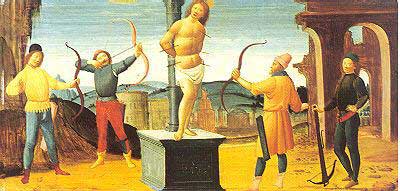httpv://www.youtube.com/watch?v=qGO0wbRdI4Y
Glenn Gould Bach Chromatic Fantasy BWV 903
httpv://www.youtube.com/watch?v=qGO0wbRdI4Y
Glenn Gould Bach Chromatic Fantasy BWV 903

The following is purely some associative riffing, but the eye-catching Sebastiane poster coincides with some of my reading of Frye at the moment. Struggling to nail down the quadrants of Eros and Adonis in his Great Doodle, Frye records the following entries in Notebook 6 of The “Third Book” Notebooks:
[11] The arrow is of course a central Eros image: in Dante’s Paradiso there is an arrow image in practically every canto. All ladders of love or perfection, Platonic or mystical, are erotic.
[13] (Kierkegaard was an Adonis figure, & I suppose the book called Stages on Life’s Way is the existential and tragic answer to Hegel, though it begins with some brilliant remarks about Eros & the comic). Incidentally, Kierkegaard speaks of the thorn in the flesh: Eros shoots arrows; figures stuck full of arrows, St. Sebastien & Actaeon, are Adonis figures.
[42] Everybody who knows, including Blake, agrees that Eros and Adonis are the same person, the continuous identity of an Orc-Luvah who is born as one and dies as the other. . . .
Frye then goes on to speak of the Protestant tendency to reject Eros (Milton and Kierkegaard) in contrast with the Catholic Dante who goes through Eros:
Both [Milton and Kierkegaard] focus on a rejection of Eros, Milton on divorce, oppposition to the C of L [Court of Love] code, and everything else inductive to the sin of Eve, Kierkegaard on the refusal to marry a woman who was in the ‘aesthetic’ sphere–Dido’s abandonment again. Under Eros I’ve got the St. Sebastian-Actaeon figure of Adonis stuck full of arrows & S.K.’s [Soren Kierkegaard’s] thorn in the flesh.
And in Notebook 12 [86]:
Birds: Eros shoots arrows & they hit himself as Adonis or St. Sebastien. The lecherous sparrow, the bird of Eros, kills the Adonis bird cock robin with the red breast, & the (female) nightingale pierces her breast with a thorn to sing. . . .
The plot of Sebastiane of course, as that of Beau Travail, appears to be very close to that of Melville’s Billy Budd, which features the same kind of Adonis or Orc-Luvah figure. The homosexual theme is central in all three works, along with the theme of sexual jealousy or envy (from what I can tell from the Wikipedia summaries: I haven’t seen either film, I am afraid, but am inspired to do so now).
Is this then the basis, archetypally speaking, of the apparently motiveless malignity of Judas’s treachery? Interestingly, Frye rejects the motive of thirty pieces of silver as not deep enough (it is part of the typological design at any rate), and implies that Judas is an Iago or Claggart type, or the other way around. Frye places Jesus not only in the Adonis quadrant–“the story of Jesus is given the Adonis or passion form” (114)– but in the homoerotic context of a man who leaves his mother and family to gather around himself, like Socrates, a group of loving young men. Both the homoeroticism and the Christ symbolism in Billy Budd is explicit: Billy is both an Adonis and a Jesus surrounded by loving male admirers and betrayed by one of them who “fain would have loved him except for fate and ban.”
Frye says in note 40 of Notebook 6 that “Eros moves away from the shadow” (the double of descent), “Adonis towards it,” and then observes in the next note:
Closely linked with this is the theme of friendship or male love: Plato’s pupil-teacher love is perhaps–in fact certainly–Eros, but the beautiful youth of Shakespeare’s sonnets, the theme in FQ [The Faerie Queene, bk. 4], the beloved disciple of Jesus, are all Adonis figures.

As it’s the eve of Thanksgiving, this poignant little memoir published in The Globe & Mail eight years ago seems appropriate.
FACTS & ARGUMENTS ESSAY from the Toronto Globe and Mail, April 25, 2001.
Escalating insight into a subway friend. Probably the big reason he enjoyed talking to me was that I didn’t know and didn’t care who he was.
By GLORIA BOYD
I took a French literature course at the University of Toronto 22 years ago. Since parking was difficult, I would take the bus and the subway to class. Every time I tried to get off the bus, the exit was blocked by an elderly, portly gentleman dressed in a dark coat. I would brush past him with a swift, “Excuse me,” and run down the subway stairs, only to find that there was no train.
Eventually, the old man ambled down and gave me an amused look, as if he wanted to say, “You see, there’s no point in rushing.” Three times a week I would stand on the platform, anxiously looking to the left to see if a flickering light emerging from the tunnel would announce the approaching train. Afterwards, I would turn my head in the opposite direction to watch the old man walk down the stairs. He walked slowly and patiently, distributing his weight evenly over each step with precision and determination. The train must have known to wait for him, as it always pulled in obligingly as he reached the platform.
After a while he started to smile at me and I smiled back. Then the smiles turned into “Good morning,” and one day he sat down beside me and we started to talk. We never bothered to introduce ourselves and talked about impersonal subjects—the theatre, cinema and travel. He told me that he was going to take his wife to Australia, and I talked about my impending visit to my native Hungary. I began to look forward to my subway rides with the old man. Looking back now, I realize that I did most of the talking and he listened patiently to my incessant silly chatter.
Then one day I had to tell him, “I’m sorry, I can’t talk to you today. I have to analyze a poem.” I explained that I was taking a French literature course at the University of Toronto and added, “I don’t know if you know anything about poetry, but I find it most confusing.”
The old man didn’t answer, and sat silently beside me as I read and re-read a poem by Rimbaud. It wasn’t until I closed my book that he turned to me and asked, “What seems to be your problem? Is it the French?”
“Oh, no. My French is fine. It’s just that poetry is taught so differently now from the way it was when I went to school, and all those metaphors and similes drive me crazy.”
The old man said he would like to recommend a book which might help me. He didn’t strike me as someone who knew much about literature, but I wasn’t going to hurt his feelings, and obediently wrote down the title of the book. After I left him, I realized he hadn’t told me the name of the author. I went back to him as he was coming up the escalator and said, “You didn’t tell me who wrote the book.”
“I did,” he replied quietly.
A little surprised, I asked “So, what’s your name?”
He answered shyly, almost inaudibly, “Northrop Frye.”